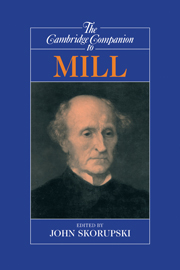Book contents
- Frontmatter
- Introduction
- 1 Mill on language and logic
- 2 Mill, mathematics, and the naturalist tradition
- 3 Mill on induction and scientific method
- 4 Mill, phenomenalism, and the self
- 5 Mill on religion
- 6 Mill on psychology and the moral sciences
- 7 Mill's utilitarianism
- 8 Mill's political economy
- 9 Civilization and culture as moral concepts
- 10 Democracy, socialism, and the working classes
- 11 The subjection of women
- 12 Mill and the Classical world
- 13 The reception and early reputation of Mill's political thought
- 14 Mill in a liberal landscape
- Guide to further reading
- Bibliography
- Index
Introduction
Published online by Cambridge University Press: 28 May 2006
- Frontmatter
- Introduction
- 1 Mill on language and logic
- 2 Mill, mathematics, and the naturalist tradition
- 3 Mill on induction and scientific method
- 4 Mill, phenomenalism, and the self
- 5 Mill on religion
- 6 Mill on psychology and the moral sciences
- 7 Mill's utilitarianism
- 8 Mill's political economy
- 9 Civilization and culture as moral concepts
- 10 Democracy, socialism, and the working classes
- 11 The subjection of women
- 12 Mill and the Classical world
- 13 The reception and early reputation of Mill's political thought
- 14 Mill in a liberal landscape
- Guide to further reading
- Bibliography
- Index
Summary
THE FALL AND RISE OF A REPUTATION! MILL AND MODERNISM
I cannot go on - Mill is dead! I wonder if this news will have affected you as it does me....
So Henry Sidgwick wrote after John Stuart Mill's death on 7 May 1873. Several days later he continued:
Mill's prestige has been declining lately: partly from the cause to which most people attribute it - the public exhibition of his radicalism: but partly to the natural termination of his philosophical reign - which was of the kind to be naturally early and brief. ... I should say that from about 1860- 65 or thereabouts he ruled England in the region of thought as very few men ever did. I do not expect to see anything like it again.
This indicates Mill's influence at its peak as well as presaging its decline. Four decades later, Balfour wrote that Mill's authority in the English Universities had been “comparable to that wielded... by Hegel in Germany and in the middle ages by Aristotle”, and Dicey noted that “John Mill was between 1860 and 1870 at the height of his power. His authority among the educated youth of England was greater than may appear credible to the present generation”. It was already becoming necessary to explain how influential Mill had been.
- Type
- Chapter
- Information
- The Cambridge Companion to Mill , pp. 1 - 34Publisher: Cambridge University PressPrint publication year: 1998
- 5
- Cited by



